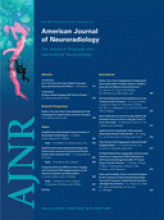Abstract
BACKGROUND AND PURPOSE: Cerebral venous thrombus (CVT) signal intensity is variable on MR imaging, and the appearance of CVT on gradient recalled-echo (GRE) sequences has been incompletely assessed. This study was performed to evaluate the GRE imaging appearance of CVT in different stages of thrombus evolution and its relationship to signal intensity on other MR pulse sequences.
MATERIALS AND METHODS: The clinical and MR imaging findings in 18 patients with CVT and GRE imaging were reviewed. Sixty-nine thrombosed venous segments were evaluated, and the signal intensity of thrombus relative to gray matter was determined. The degree of thrombus susceptibility effect (SE) was assessed and related to time of imaging after onset of symptoms (clinical thrombus age) and appearance on other pulse sequences. Segments were classified as SE+ (demonstrating susceptibility effect) or SE− (no susceptibility effect).
RESULTS: Thirty-six venous segments exhibited visible SE. SE+ segments had a clinical thrombus age that was less than that in SE− segments (8.1 versus 24.6 days, P = .003). Sixty-three percent (23/36) of SE+ segments exhibited hypointensity on T2-weighted images (T2WI) versus 12% (4/33) of SE− segments (P < .001). Twenty-nine of 32 (90.6%) segments with clinical thrombus age of 0–7 days were SE+, versus 7 of 30 (23.3%) segments with a thrombus age of 8 days or greater.
CONCLUSION: SEs from CVT can be detected with GRE imaging and are most prevalent in patients with hypointense thrombus on T2WI within 7 days after the symptom onset. This correlates with the paramagnetic effects of deoxyhemoglobin in acute stage thrombus. GRE imaging may be useful in detecting thrombus in this stage when difficult to detect on other pulse sequences.
- Copyright © American Society of Neuroradiology












